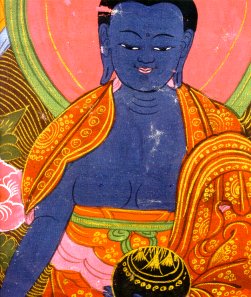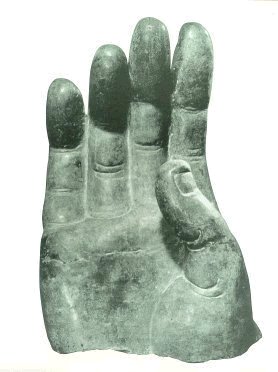| Contents
103.2 Practices for Developing Compassion 103.3 Tonglen 103.4 Dzogchen (The Great Perfection) 103.5 Six Vajra Verses 103.6 Mahamudra For Tantric Buddhism, the universe is identical with the Buddha - all its dimensions and qualities consist of Buddha's manifestations and becoming a Buddha thus means merging with the universe. It can be achieved through analytical study and intellectual meditation. However, the meditation in traditional Buddhism is obviously different from that in Tantric Buddhism. According to the Highest Yoga Tantra, our body and mind exist not only on the gross level (physical form), but also on subtle level, the so-called Vajra body, having the connotation of indestructible. However, the former is composed of various material elements, and is subject to the inevitable sufferings of sickness, decay and death. Just like that the physical body is pervaded by ordinary nervous system, the subtle Vajra body is pervaded by thousands of channels [脈] (Nadi in Sanskrit, Tsa in Tibetan) through which the subtle energy winds [氣] (Prana in Sanskrit, Lung in Tibetan) and drops [點] ( Bindu in Sanskrit, Tigle in Tibetan) that are the source of the bliss so vital to the Highest Tantric practice. Most people are not aware of the subtle conscious body, but the Tantric practitioner can discover and make use of it. The most important channel is the central one called 'central channel', which runs in a straight line from the crown of our head down to an area in front of our spine, and along several focal points known as Chakras, or energy wheels [輪]. Each one serves a different function in the practice of Tantra. The most important Chakra is the one located at the level of the heart, because the heart Chakra is the home of our very subtle mind, This very subtle mind has been with us from conception, for lifetimes without beginning. As the fundamental consciousness abiding at our heart center throughout this life, the very subtle mind is sometimes referred to as our Residential Mind. It is actually our original, fundamental Nature, which can only be realized upon awakening. In Vajrayana, it is said that subtle channels are the body of awakening, subtle winds are the speech of awakening and the drops are the awakened mind. From the point of view of Buddhahood, the channels are the body of emanation, the winds are the body of perfect experience, and the drops are the absolute body. By cultivating a profound concentration on the Vajra body in general and upon the central channel in particular, they are able to cut through the gross levels of mental functioning and make contact with their original Residential Mind. Making use of this Mind, they can meditate on the emptiness of self-existence and penetrate the ultimate nature of reality, thereby freeing themselves of all delusions. At the same time that this totally absorbed into an explosion of incredible blissful energy. The unity of great bliss and the simultaneous comprehension of emptiness (known as Mahamudra) is the quickest path towards perfect and complete enlightenment. For details, see the section 103.6. 
103.2 Practices for Developing Compassion
Compassion and wisdom are
the two pillars in the support of Buddhism. In Tibetan Buddhism, the
practices for developing compassion are plentiful. Compassion can
emerge spontaneously, but it is usually borne from an understanding
of the interdependent and impermanent nature of reality. There are
some practices aimed at inspiring feelings of compassion. For instance,
'The Eight Verses on Thought Training' by the Kadampa master, Langri
Thangpa. The practitioners have to contemplate and meditate on compassion
as follows:
By thinking of all sentient beings Wherever I go, with whomever I go, May I examine my mind in all actions When I see beings of a negative disposition Whenever others, due to their jealousy, When someone whom I have helped In short, may I offer both directly and indirectly May they not be defiled by the concepts Tonglen is a meditation practice to develop Bodhicitta in Tibetan Buddhism. Tonglen literally means 'Giving and Receiving'. It is also regarded as the Second Foundation Yoga or Mula Yoga. See section 101.3 The seventh verse of The Eight Verses on Thought Training is often referred in the practice of Tonglen. First, the practitioner is required to reflect on the equality of oneself and others, and to extend it to all beings in the six realms. One should then reflect upon the disadvantages of caring only for ourselves, and understand that selfishness is the cause of sufferings in our lives, thus developing a powerful sense of helping others. Moreover, one should reflect that this attitude is the source of happiness and the key to the door of Enlightenment. 
103.4 Dzogchen (The Great Perfection) According to the Nyingma tradition. the first transmission of Dozgchen [大圓滿] was Garab Dorje, who received it from Buddha Vajrasattva in Oddyiyana. It passed on to Shir Singha, Jnanasutra, then Vimalamitra and Padmasambhava. The latter two formed two major lines of transmission of Dzogchen in Tibet. Dzogchen is always described as a state of great perfection, the absolute fruition of the qualities of enlightenment, subsequent to a systematic order in teachings and practices. First of all, the teachings are divided into three series: the mind series, the space series and the instruction series. For the practices, it begins with Trek-cho, 'direct cutting', then proceeds with To-gal, 'leap over', just like 'Chi' and 'Kuan' in Tien Tai sect. However, before one can start the practices of Dzogchen, one has to practice a series of preliminaries, which serves the pre-requisites in order to avoid spiritual chaos and conceit in the proper practices of Trek-cho and To-gal. The preliminaries consist of two parts. The first part is the fourfold contemplation, often known as the Four Thoughts that Turn the Mind to Dharma, based on the teachings in the Sutras. It covers
The second part is the five meditations which are the inner practices based on the Sutras and Tantras. It covers
In addition to the preliminaries, one might practice in Mahayoga utilizing the power of the eight deities, such as Vajrakilaya for assistance. Once the preliminaries are well practiced, one can proceed to Trek-cho and To-gal. Trek-cho involves a transmission of awareness from a Vajrayana master. The practitioner is to cut all emotional disturbances, false thoughts, and even meditating experiences, and to bring directly to the underlying purity of awareness. Advancing to To-gal, one will utilize extremely esoteric methods to transform one's vision. For instance, the whole world is visualized as a Mandala, the residing place of the Buddhas. Those who achieve and master To-gal can obtain the Wisdom-body of a Buddha, a state of perfection. The Six Vajra Verses explain the primordial condition of the individual, summing up the essence of the base (or fundamental perception), the path (or the methods to practice) and the fruit (or the effect and result as behavior) of Dzogchen. It is part of the teachings originally transmitted by Garab Dorje, containing the essential points of a number of Tantras. The Six Vajra Verses are as follows: The nature of phenomena
is non-dual, In the three parts of two lines each that make up the total of six lines, are to be found the principles of the base, the path, and the fruit, alongside a simultaneous explanation of the Way of seeing, the Way of practicing and the Way of behaving, according to the Dzogchen teachings. Mahamudra [大手印] is the quintessential approach in the practice of Buddha Dharma, for which some understanding of the nature of mind is necessary. There are three aspects of Mahamudra: 
A deeper understanding of the nature of the mind in Foundation Mahamudra can be achieved through the process of Path Mahamudra, until a thorough and complete stage of appreciation. The Fruition Mahamudra is the actualization of the transcendence in awareness with the Dharmakaya, Sambhogakaya and Nirmanakaya as the facets of completely enlightened experience. The nature of the mind is that it is 'essentially empty', yet it is 'luminous potential to cognize' and 'unobstructed in dynamics'. In reality, it is indescribable in words. As a metaphor, the emptiness of mind is the ocean; the luminosity of mind is the sunlit ocean; and the unobstructed dynamic quality of mind is the waves of the sunlit ocean. The unity of the three aspects forms the seed or potential for enlightenment Commencing the practice of Foundation Mahamudra, the theoretical understanding of the Mahamudra approach is introduced or 'transmitted' by a qualified teacher. The practitioner then starts to apply the concept in his daily life, and verify with his own experience, which, though it is not the ultimate one. To directly experience the nature of the mind itself requires meditation and contemplation, and sometimes the so-called 'beyond meditation'. |


